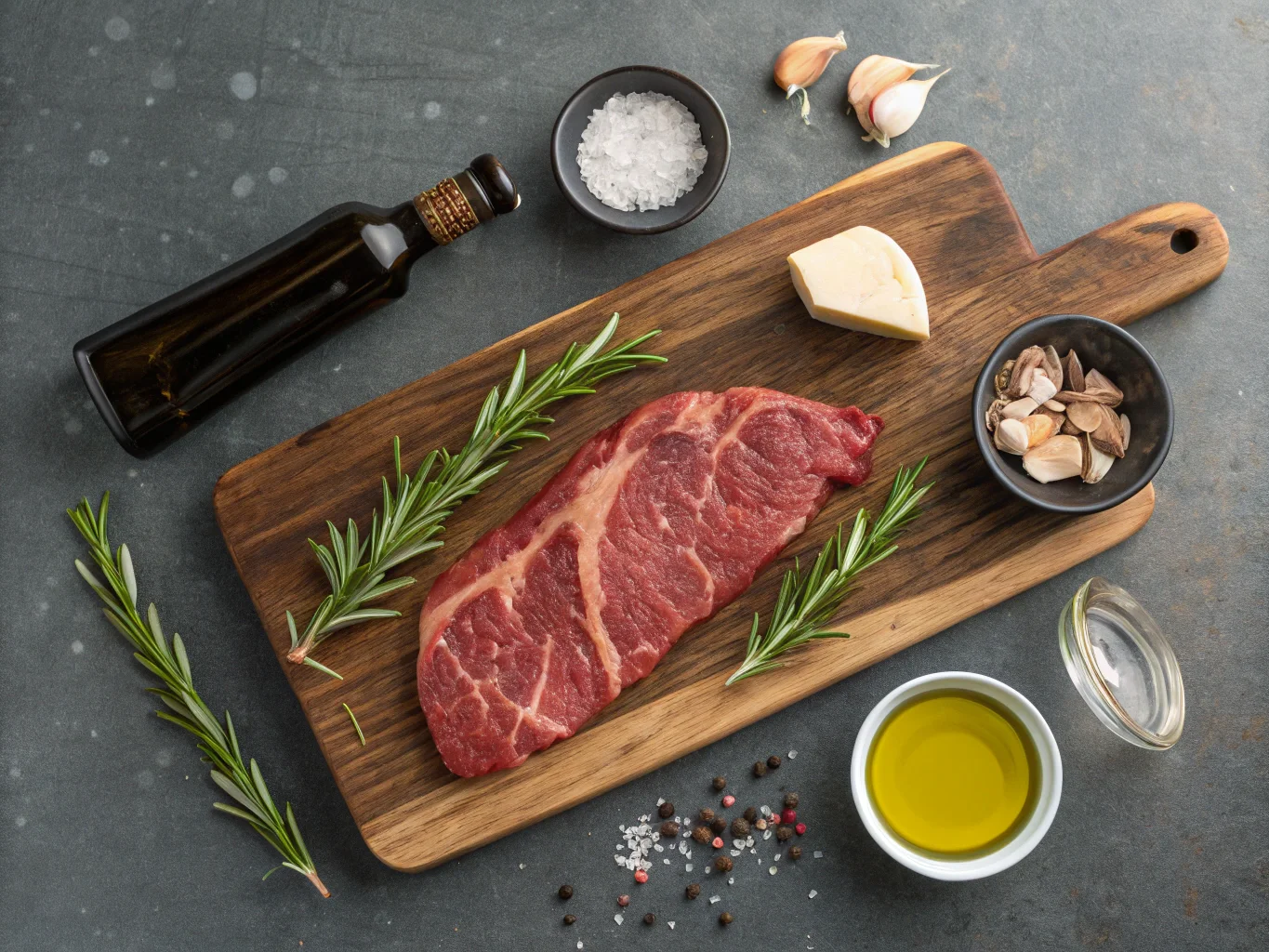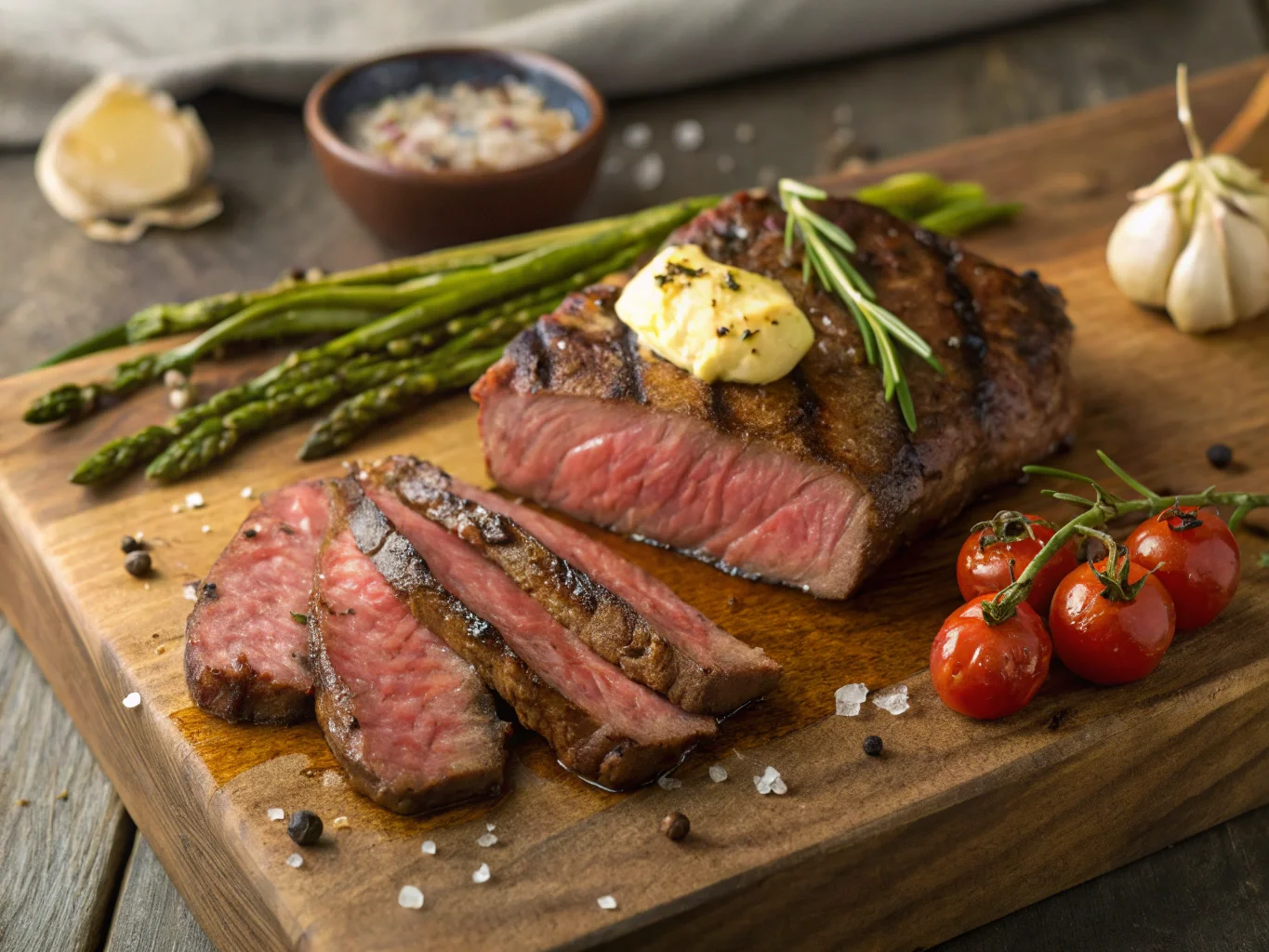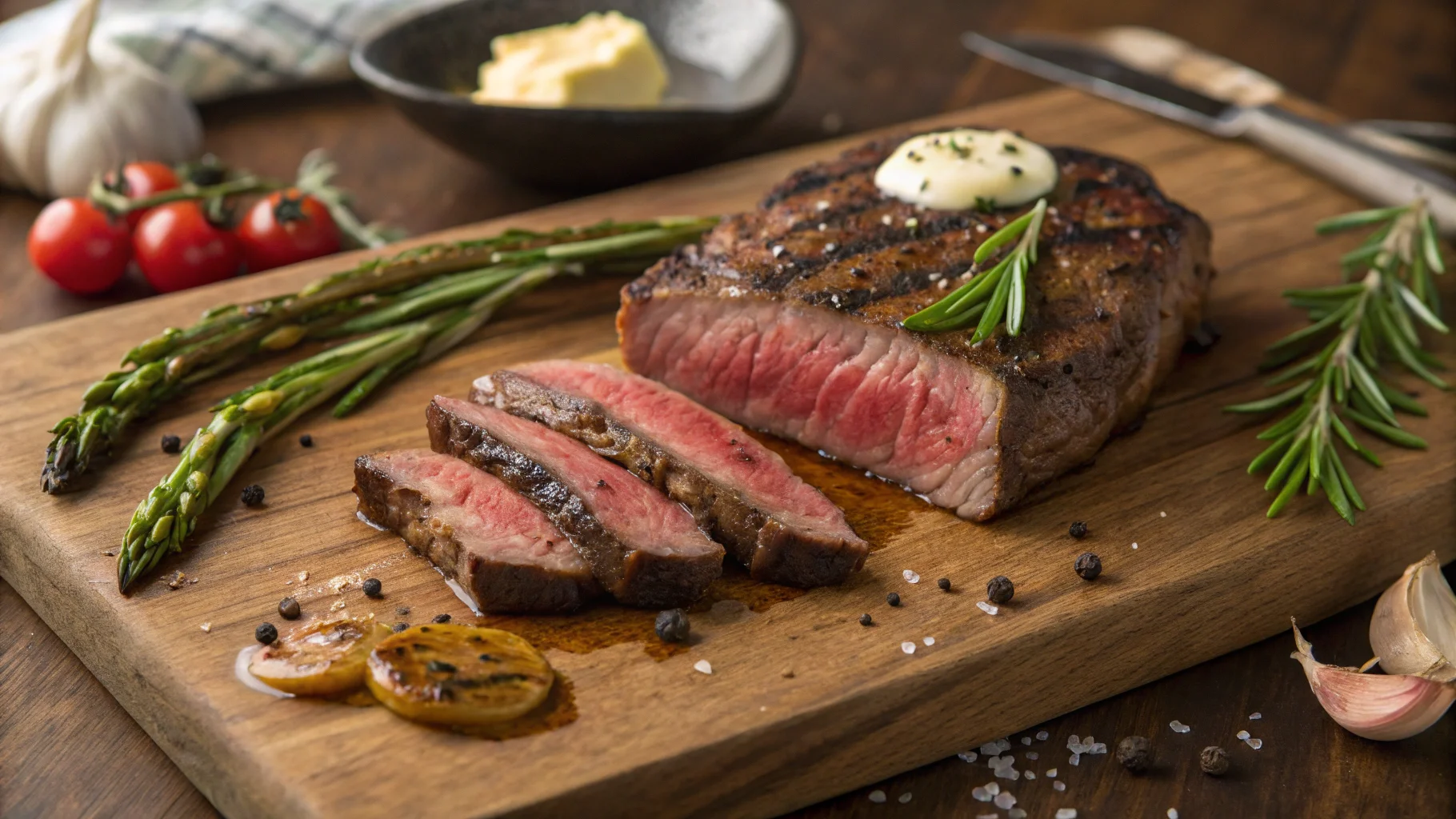There’s something mesmerizing about the sizzle of a well-marbled flat iron steak hitting a scorching cast iron surface. That initial symphony of sound, followed by an aroma that transforms your kitchen into a high-end steakhouse, creates a moment of pure culinary anticipation. For many, including myself, these sensory experiences connect us to deeper memories—Sunday gatherings where relatives transformed humble ingredients into memorable feasts, proving that cooking transcends mere sustenance.
- Bist Amazon Picks:
Whether you’re scrambling to prepare a dinner that impresses despite your packed schedule, or you’re determined to master steakhouse-quality results without the steakhouse prices, this 10-minute flat iron method will revolutionize your home cooking approach. Through countless tests and refinements, I’ve distilled this technique to its essential elements, and now it’s your turn to benefit from this culinary shortcut.
What You’ll Discover Below
- Why flat iron steak delivers exceptional flavor while remaining budget-friendly
- A precise, timed approach to achieve perfect doneness in just 10 minutes
- How your cast iron skillet becomes the secret weapon for restaurant-worthy results
- Expert recommendations for complementing and serving your masterpiece
What Makes Flat Iron Steak Special: Understanding This Hidden Gem
The Story Behind Your New Favorite Cut
Flat iron steak represents a fascinating culinary redemption story. Butchers historically overlooked this shoulder section (technically the top blade) or relegated it to stew meat due to a thick seam of connective tissue. Modern butchering techniques emerged in the early 2000s that revealed what had been hiding in plain sight—an incredibly tender cut with spectacular marbling and flavor potential.
Why Flat Iron Excels in Quick-Cooking Scenarios
Few cuts balance convenience and quality like flat iron steak. Consider these advantages:
- Remarkable tenderness (second only to filet mignon in scientific measurements)
- Natural marbling that creates self-basting magic during cooking
- Consistent thickness from end to end, eliminating guesswork
- Cost-effectiveness that typically runs 30-40% less than premium cuts
- Forgiving nature that helps even novice cooks achieve impressive results
The flat iron’s rectangular shape and even thickness make it particularly suited for the precision timing of our 10-minute method. Unlike irregularly shaped cuts that cook unevenly, flat iron provides consistency from edge to center.
Why Cast Iron Creates Steak Perfection
The Science Behind Cast Iron’s Magic
Your relationship with cast iron might be new or generations old, but understanding why it outperforms other cookware for steak preparation elevates your cooking intelligence. Cast iron’s molecular structure creates unique advantages:
- Unmatched heat retention that maintains consistent cooking temperatures
- Microscopic surface irregularities that create ideal contact points for caramelization
- Natural seasoning that develops over time, enhancing flavor compounds
- Seamless transition from stovetop to oven when needed
Finding Your Ideal Cast Iron Partner
While any cast iron skillet can work, specific characteristics optimize your steak-cooking experience:
| Feature | Recommendation | Why It Matters |
|---|---|---|
| Size | 10-12 inches | Provides adequate surface area without crowding |
| Seasoning | Well-established patina | Creates natural non-stick properties |
| Handle | Heat-resistant design | Allows manipulation during high-heat cooking |
| Thickness | Minimum 1/4 inch base | Ensures even heat distribution without hot spots |
Investing in quality cast iron represents one of the smartest culinary decisions you’ll make—these workhorses routinely provide decades of service when properly maintained.
Gathering Your Ingredients for Flat Iron Perfection
Selecting Your Star Performer
Begin with thoughtful selection of your centerpiece:
| Ingredient | Specification | Selection Tips |
|---|---|---|
| Flat Iron Steak | 1 to 1.5 pounds | Look for even thickness and consistent marbling |
| Thickness | 3/4 to 1 inch | Avoid thinner cuts which overcook easily |
| Temperature | Room temperature | Remove from refrigeration 30 minutes before cooking |
Flavor Enhancement Strategy
Simplicity often yields the most extraordinary results:

| Ingredient | Amount | Quality Considerations |
|---|---|---|
| Kosher Salt | 1-2 teaspoons | Coarse crystals adhere better than table salt |
| Black Pepper | 1 teaspoon | Freshly ground releases more aromatic compounds |
| Cooking Oil | 2 tablespoons | Choose avocado, grapeseed or refined olive oil |
| Butter | 2 tablespoons | Unsalted allows better seasoning control |
| Garlic | 2-3 cloves | Crushed releases more flavor than minced |
| Fresh Herbs | 2-3 sprigs | Woody herbs like rosemary or thyme withstand heat |
Notice the deliberate restraint here—when working with exceptional ingredients, your role becomes highlighting rather than masking their natural characteristics.
Your 10-Minute Roadmap to Steak Excellence
Preparation: Setting Yourself Up for Success
Before starting the 10-minute countdown:
- Allow your steak to reach room temperature (30 minutes minimum)
- Thoroughly pat surfaces dry with paper towels (moisture inhibits browning)
- Season generously with salt and pepper on all sides, pressing seasonings into the meat
- Heat your cast iron skillet over high heat until it begins to smoke lightly
These preliminary steps create the foundation for everything that follows. Particularly crucial is removing surface moisture—this single step determines whether you’ll achieve a proper sear or merely steam your investment.
Minutes 1-2: Creating the Perfect First Impression
The initial phase focuses entirely on developing that coveted crust:
- Add oil to your screaming-hot skillet (it should shimmer immediately)
- Position your steak in the center with deliberate confidence
- Resist the temptation to peek or move it for a full 120 seconds
This discipline separates adequate results from exceptional ones. Moving the steak prematurely interrupts the Maillard reaction—that complex chemical process responsible for developing hundreds of flavor compounds.
Minutes 3-4: Balancing Your Approach
With your foundation established:
- Flip your steak using tongs (never pierce with forks)
- Allow the second side to develop comparable caramelization
- Monitor heat level carefully, reducing slightly if needed
Pay attention to visual and aromatic cues during this phase. A deep amber color signifies proper development, while blackening indicates excessive heat that requires adjustment.
Minutes 5-7: Introducing Complexity
Now elevate the experience:
- Reduce heat to medium-high
- Add butter, crushed garlic, and herb sprigs alongside the steak
- Tilt the pan slightly, collecting the butter mixture
- Spoon this liquid gold repeatedly over the steak’s surface
- Flip once during this period for even basting
This basting technique delivers fat-soluble flavor compounds directly to the meat’s surface while adding a subtle richness that basic cooking methods miss entirely.
Minutes 8-10: Precision Finishing
The final moments determine your outcome:
- Check internal temperature using a reliable instant-read thermometer
- 125°F yields rare doneness
- 135°F produces medium-rare (optimal for flat iron)
- 145°F results in medium doneness
- Remove the steak when it registers 5°F below your target temperature
Temperature monitoring represents the single most important technical skill in steak preparation. The carryover cooking phenomenon—where internal temperature continues rising after removal from heat—accounts for that strategic 5°F buffer.
The Critical Resting Phase
After your 10-minute active cooking concludes:
- Transfer your masterpiece to a cutting board
- Tent loosely with aluminum foil (tight wrapping steams the crust)
- Allow a full 5-minute rest (non-negotiable)
- Slice perpendicular to the visible grain structure
This resting period allows protein strands to relax and reabsorb juices that would otherwise pour out upon cutting. Your patience here directly translates to juiciness on the plate.
Solving Common Flat Iron Challenges
When Texture Disappoints

If your results seem tough despite proper cooking:
- Examine your cutting technique—slicing with (rather than against) the grain multiplies chewiness
- Verify cooking temperature—exceeding medium doneness sacrifices tenderness
- Check steak quality—inadequate marbling limits natural tenderizing effects
When Flavor Falls Flat
Underwhelming taste experiences typically stem from:
- Timid seasoning—flat iron benefits from generous salt application
- Skipping the basting phase—butter-herb infusion adds crucial complexity
- Using a poorly seasoned skillet—mature cast iron contributes subtle flavor notes
Managing Smoke Concerns
Excessive smoke during cooking usually indicates:
- Oil with insufficient smoke point (switch to avocado or safflower)
- Skillet overheating beyond necessary temperatures
- Residual factory coatings on newer skillets
Elevating Your Flat Iron Experience
Creating Harmonious Plates
Thoughtfully selected accompaniments enhance your centerpiece:
- Roasted fingerling potatoes with herbs complement the meaty richness
- Quick-sautéed seasonal vegetables provide textural contrast
- Peppery arugula dressed simply with lemon and olive oil offers brightness
- Compound butter melting over the sliced steak adds luxurious finish
Selecting Liquid Companions
Consider these pairing strategies:
| Wine Category | Specific Recommendations | Pairing Logic |
|---|---|---|
| Bold Reds | Malbec, Cabernet Sauvignon | Tannins complement the meat’s richness |
| Medium Reds | Sangiovese, Tempranillo | Bright acidity balances fatty elements |
| Alternative | Craft stout, aged bourbon | Malty/caramel notes enhance umami flavors |
Creative Variations on Your Flat Iron Foundation
Global Flavor Profiles
Explore these regional interpretations:
- Southwest Approach: Incorporate cumin, ancho chile powder and oregano into your seasoning, finishing with chimichurri sauce
- Asian-Inspired: Apply a quick marinade of soy sauce, ginger and garlic before cooking, serving with scallion-sesame garnish
- Mediterranean Expression: Finish with lemon zest, fresh oregano and quality olive oil alongside olives and feta
Transformational Serving Styles
Expand your repertoire with these preparations:
- Composed Salad: Position sliced steak over bitter greens with blue cheese, walnuts and balsamic reduction
- Artisan Sandwich: Layer between crusty bread with caramelized onions, arugula and horseradish aioli
- Street Tacos: Fill warmed corn tortillas with thinly sliced steak, quick-pickled onions and cilantro
Extending Your Flat Iron Experience
Proper Storage Approach
Maximize quality of leftovers by following these guidelines:
| Storage Method | Maximum Duration | Technique Details |
|---|---|---|
| Refrigeration | 3-4 days | Wrap loosely in butcher paper, then place in container |
| Freezing | Up to 3 months | Double-wrap in freezer paper and place in sealed bag |
Thoughtful Reheating Strategy
Preserve your initial achievement:
- Allow refrigerated steak to reach room temperature
- Heat cast iron skillet to medium-low
- Add 2 tablespoons beef broth or water to create steam
- Cover and warm gently for 2-3 minutes
- Finish with a quick 30-second sear per side
This approach reheats without additional cooking, maintaining your carefully achieved doneness level.
Your Most Common Flat Iron Questions Answered
How can I determine when my flat iron steak reaches perfect doneness?
While instant-read thermometers provide the most reliable results, the finger test offers a practical alternative. Press the steak lightly—rare feels like the base of your thumb when thumb and index finger touch; medium-rare corresponds to thumb and middle finger; medium resembles thumb and ring finger. For flat iron steak specifically, aim for 135°F internal temperature to maximize this cut’s unique characteristics.
Does marinating flat iron steak improve results with the cast iron method?
While flat iron steak naturally possesses excellent flavor, brief marination (1-2 hours maximum) can introduce complementary notes. Oil-based marinades with acidic components work particularly well. However, thoroughly pat the steak dry before cooking, as residual moisture prevents proper searing. Consider marinade elements like balsamic vinegar, Worcestershire sauce, or citrus juices paired with aromatics.
Why does my flat iron steak sometimes remain tough despite following timing recommendations?
The most overlooked factor in flat iron tenderness is cutting technique. This particular cut features a distinctive grain pattern that must be sliced perpendicular to these fibers. Cutting parallel to the grain creates chewy results regardless of perfect cooking. Additionally, flat iron benefits from slightly less cooking than you might prefer for other cuts—embrace medium-rare for optimal tenderness.
Can I substitute other cooking fats for the recommended oil and butter combination?
The two-stage fat approach (high-smoke-point oil for searing, butter for flavor finishing) provides optimal results, but alternatives exist. Clarified butter or ghee works for both stages due to its high smoke point. Bacon fat introduces smoky notes but requires careful temperature monitoring. Avoid unrefined oils like extra virgin olive oil for the initial sear, as their low smoke points produce bitter compounds at high temperatures.
What advantages does cooking flat iron steak in cast iron offer compared to grilling?
Cast iron creates consistent surface contact that grilling can’t match, resulting in more uniform caramelization. The skillet method also facilitates the butter-basting technique that introduces fat-soluble flavors throughout the cooking process. Furthermore, cast iron provides precise temperature control that helps less experienced cooks achieve reliable results. Consider cast iron your controlled environment for mastering steak fundamentals before expanding to grilling techniques.
Conclusion: Your Path to Flat Iron Mastery
Transforming an affordable flat iron steak into a memorable dining experience requires neither professional training nor elaborate equipment—just ten focused minutes and a trusted cast iron skillet. This method combines accessibility with exceptional results, democratizing what once seemed the exclusive territory of steakhouse chefs.
Remember that while cooking follows scientific principles, it ultimately expresses personal preference and creativity. As you grow comfortable with this technique, adapt it to reflect your unique taste—adjusting seasoning profiles, exploring different aromatics, or modifying cooking times slightly to match your ideal doneness level.
Whether preparing a quick weeknight dinner that elevates the ordinary, or impressing weekend guests with your culinary prowess, this 10-minute flat iron method delivers consistent excellence. Your cast iron skillet becomes more than a cooking vessel—it transforms into an essential partner in creating meals that gather people around your table, creating memories through shared experiences.
What surprising combination or serving style will you discover with your perfectly cooked flat iron steak? Share your creations and questions in the comments below, and let’s continue exploring the possibilities together!

